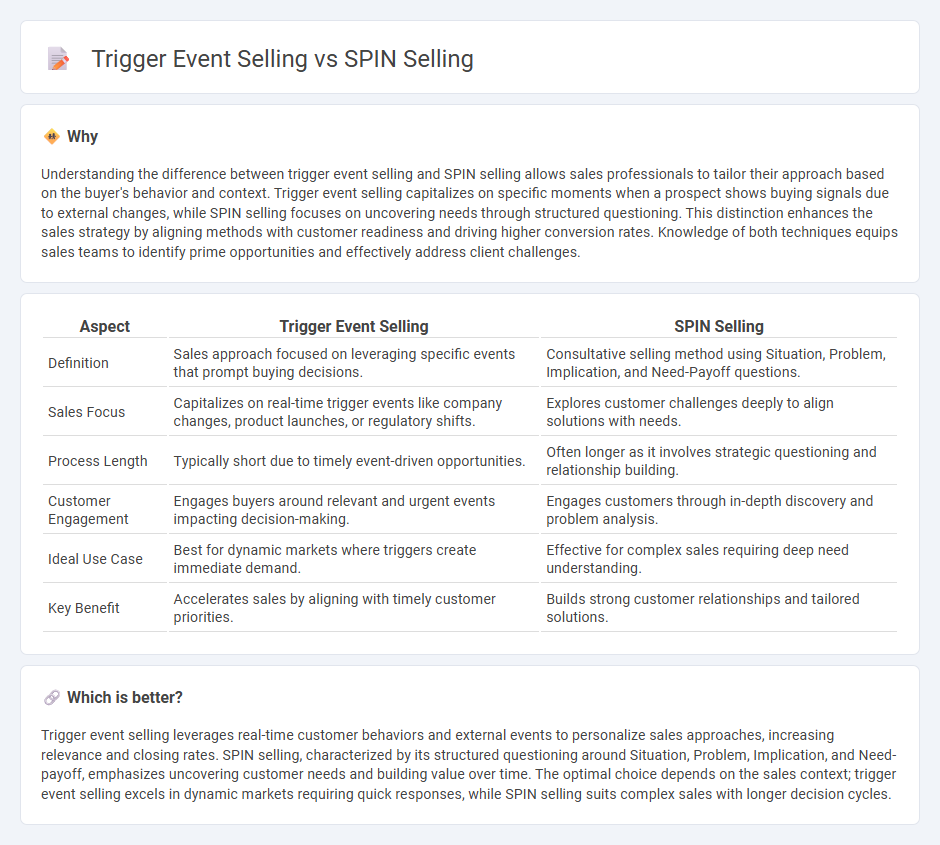
Trigger event selling leverages real-time customer activities such as acquisitions, expansions, or personnel changes to identify timely sales opportunities, ensuring messages are highly relevant and personalized. SPIN selling focuses on a consultative approach using Situation, Problem, Implication, and Need-Payoff questions to deeply understand and address customer pain points. Discover how integrating these methods can enhance your sales strategy and close deals more efficiently.
Why it is important
Understanding the difference between trigger event selling and SPIN selling allows sales professionals to tailor their approach based on the buyer's behavior and context. Trigger event selling capitalizes on specific moments when a prospect shows buying signals due to external changes, while SPIN selling focuses on uncovering needs through structured questioning. This distinction enhances the sales strategy by aligning methods with customer readiness and driving higher conversion rates. Knowledge of both techniques equips sales teams to identify prime opportunities and effectively address client challenges.
Comparison Table
| Aspect | Trigger Event Selling | SPIN Selling |
|---|---|---|
| Definition | Sales approach focused on leveraging specific events that prompt buying decisions. | Consultative selling method using Situation, Problem, Implication, and Need-Payoff questions. |
| Sales Focus | Capitalizes on real-time trigger events like company changes, product launches, or regulatory shifts. | Explores customer challenges deeply to align solutions with needs. |
| Process Length | Typically short due to timely event-driven opportunities. | Often longer as it involves strategic questioning and relationship building. |
| Customer Engagement | Engages buyers around relevant and urgent events impacting decision-making. | Engages customers through in-depth discovery and problem analysis. |
| Ideal Use Case | Best for dynamic markets where triggers create immediate demand. | Effective for complex sales requiring deep need understanding. |
| Key Benefit | Accelerates sales by aligning with timely customer priorities. | Builds strong customer relationships and tailored solutions. |
Which is better?
Trigger event selling leverages real-time customer behaviors and external events to personalize sales approaches, increasing relevance and closing rates. SPIN selling, characterized by its structured questioning around Situation, Problem, Implication, and Need-payoff, emphasizes uncovering customer needs and building value over time. The optimal choice depends on the sales context; trigger event selling excels in dynamic markets requiring quick responses, while SPIN selling suits complex sales with longer decision cycles.
Connection
Trigger event selling leverages specific business occurrences, such as mergers or product launches, to identify timely sales opportunities by addressing immediate needs. SPIN selling complements this approach by using a structured questioning technique--Situation, Problem, Implication, Need-Payoff--to deeply understand client challenges revealed during these trigger events. Combining both methods enhances sales effectiveness through contextual relevance and strategic problem solving.
Key Terms
**SPIN Selling:**
SPIN Selling emphasizes understanding customer needs through four types of questions: Situation, Problem, Implication, and Need-Payoff, enabling sales professionals to tailor solutions effectively. This method drives consultative selling by uncovering pain points and demonstrating value based on client responses, leading to higher conversion rates. Explore how SPIN Selling techniques can transform your sales strategy and boost success rates.
Situation Questions
SPIN Selling emphasizes Situation Questions to gather detailed background information, establishing context for identifying customer needs and tailoring solutions effectively. Trigger Event Selling leverages specific events or changes, such as mergers or leadership shifts, as catalysts for timely engagement, reducing the reliance on broad Situation Questions. Explore how each approach optimizes sales strategies by understanding customer context and timing for better results.
Problem Questions
SPIN Selling emphasizes uncovering customer pain points through targeted Problem Questions, helping sales professionals identify specific issues that their product can solve. In contrast, Trigger Event Selling leverages external events or changes in a prospect's environment to initiate timely and relevant conversations, often bypassing traditional problem identification. Explore how mastering Problem Questions in both strategies can transform your sales effectiveness.
Source and External Links
SPIN selling: A comprehensive guide on how it works - Zendesk - SPIN selling is a sales technique involving four stages--Opening, Investigating, Demonstrating capability, and Obtaining commitment--each aligned with types of questions designed to build relationships and gather information gradually rather than pushing a product immediately.
The SPIN Selling Method -- I Took a Deep Dive so You Don't Have to - HubSpot - Developed by Neil Rackham, SPIN selling focuses on four types of questions--Situation, Problem, Implication, and Need-Payoff--to better understand buyer needs and tactfully close deals, emphasizing questioning over closing techniques.
The 4 Steps to SPIN Selling | Lucidchart - The SPIN method consists of a strategic sequence of question types aimed at uncovering buyer situation, problems, their implications, and then showcasing how your product addresses those needs to ultimately close the deal.
 dowidth.com
dowidth.com